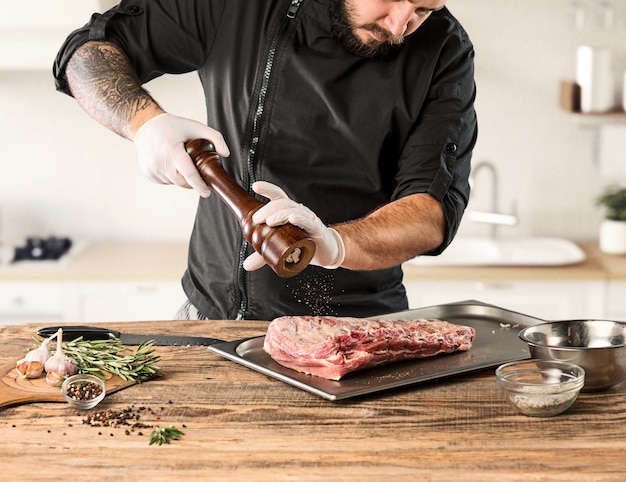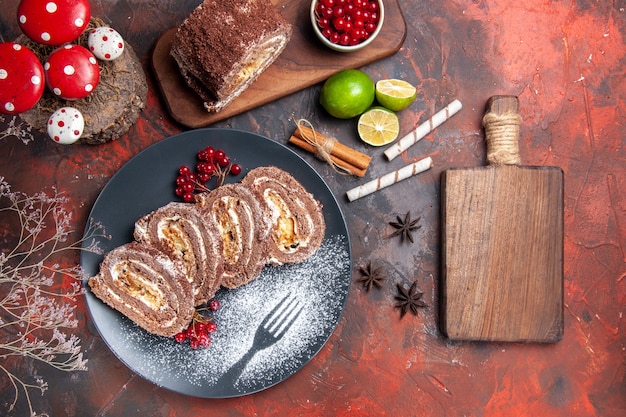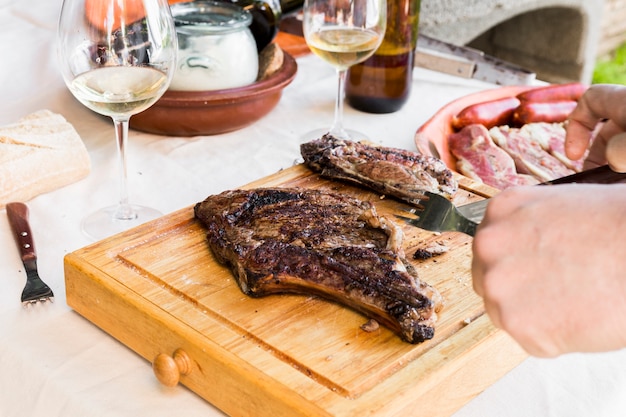Alright, you lot, listen up! We're about to tackle a culinary masterpiece that'll leave you saying, "Blimey, that was good!" We're talking about the rib eye roast, a cut of beef that's practically begging to be cooked to juicy, tender perfection. Now, I've been a home cook for years, and I've learned a few tricks along the way. So grab a cuppa, settle in, and let's embark on this culinary adventure together!
(Part 1) choosing the right cut: The Foundation of a Great Roast

Before you even think about whipping out your trusty chef's knife, let's talk about the star of the show: the rib eye roast. This beautiful cut, with its rich marbling and delicious flavour, is a guaranteed crowd-pleaser. But before you head to your local butcher, there are a few key things to keep in mind.
Rib Eye Roast: What to Look For
You want a rib eye roast that's well-marbled. This means there's a good amount of fat interspersed throughout the meat, which will contribute to the flavour and juiciness of the finished product. Picture a beautiful, intricate pattern of white fat throughout the red meat. That's what you're looking for! You'll also want a roast that's at least 2 inches thick. This ensures it cooks evenly and doesn't dry out. Imagine a lovely, thick slice, perfect for carving and serving.
Bone-In or Boneless? The Great Debate
This is where personal preference comes into play. Bone-in roasts tend to cook a bit more evenly and hold onto moisture better. The bone acts like a little heat conductor, helping to distribute the heat more evenly. However, they can be trickier to carve, and you might need a bit more muscle to get those beautiful slices. Boneless roasts are easier to work with and often easier to find. You can easily slice them up without worrying about the bone getting in the way. However, you might need to keep a closer eye on them to make sure they don't overcook. It's all about finding what works best for you!
(Part 2) Preparing the Roast: Setting the Stage for Success

Now that you've got your perfect rib eye roast, it's time to get it ready for its starring role. Trust me, a little bit of prep goes a long way. It's like giving your actor a great costume and makeup - it makes all the difference in the final performance!
Seasoning is Key: The Flavour Foundation
Don't be shy with the seasoning! A good rub is the foundation for a flavour-packed roast. It's like giving your dish a personality. I like to use a simple blend of salt, pepper, garlic powder, and onion powder. It's a classic for a reason! You can also get creative and add other herbs and spices depending on your taste. For a more complex flavour, try adding smoked paprika, cumin, or even a pinch of cayenne pepper. Remember, you can always adjust the seasoning to your preference. After all, it's your roast, your rules!
A Touch of Fat: The Secret to a Crispy Crust
One of my favourite tips for achieving a perfectly crispy crust is to rub a bit of olive oil or butter all over the roast. This helps the seasonings adhere better and creates a beautiful golden-brown colour. It's like giving your roast a little shimmer of extra goodness. Imagine that beautiful, glistening crust, just begging to be devoured!
(Part 3) Cooking the Perfect Rib Eye Roast: A Culinary Masterclass

Alright, the moment of truth is here. We're going to cook this rib eye roast to juicy, tender perfection. Let's get cooking! I've got three tried-and-true methods for you, each with its own unique charm.
The oven method: A Classic Choice for a Reason
The oven is a classic and reliable way to cook a rib eye roast. It's like a warm embrace for your meat, gently cooking it to perfection. Here's what you'll need to do:
- Preheat your oven to 450°F (232°C). You want that oven nice and hot for a good sear. It's like giving your roast a quick kiss of fire, creating a beautiful crust.
- Place the seasoned roast on a roasting rack in a roasting pan. Make sure the rack is elevated to allow air circulation around the roast. This will help it cook evenly. It's like giving your roast a little breathing room.
- Cook for 15 minutes per pound. This will give the roast a beautiful crust. It's a quick and intense burst of heat that creates that lovely golden-brown colour.
- After 15 minutes per pound, reduce the oven temperature to 325°F (163°C) and continue cooking for another 15 minutes per pound, or until the internal temperature reaches 135°F (57°C) for medium-rare. It's like letting the roast simmer in a gentle heat, allowing the juices to distribute evenly.
Remember, you can always adjust the cooking time depending on how well-done you like your meat. If you like your roast a bit pinker, aim for an internal temperature of 140°F (60°C) for medium. If you prefer your roast a bit more cooked through, go for 145°F (63°C) for medium-well. And if you like your rib eye roast well-done, cook it until the internal temperature reaches 150°F (66°C). The key is to cook it to your preference!
The reverse sear: A Modern Approach for a Juicy Interior
Here's a method that's gaining popularity for a good reason: the reverse sear. It's a technique that results in a perfectly cooked roast, with a juicy interior and a crispy crust. It's like a two-step process, leading to the ultimate tenderness. Here's how it works:
- Preheat your oven to 250°F (121°C). It's like creating a gentle, slow-cooking environment for your roast.
- Place the seasoned roast on a roasting rack in a roasting pan.
- Cook for about 2 hours, or until the internal temperature reaches 120°F (49°C) for medium-rare. It's like giving the roast a long, slow hug, allowing the juices to distribute evenly.
- Remove the roast from the oven and let it rest for 30 minutes. This allows the juices to redistribute throughout the meat. Think of it as a little rest for your roast, allowing it to regain its composure.
- While the roast is resting, preheat your oven to 500°F (260°C). It's like getting ready for a grand finale, a quick burst of intense heat.
- Sear the roast on all sides for 5-7 minutes. This will create a beautiful crust and lock in the juices. Imagine that beautiful, golden-brown crust, perfectly crisp and delicious.
The Grill: For a Smoky Flavour that Can't Be Beat
If you're lucky enough to have a grill, you can use it to cook your rib eye roast. This is a great way to add a smoky flavour to the meat. It's like giving your roast a touch of outdoor adventure. Here's how to do it:
- Preheat your grill to medium-high heat. It's like getting your grill ready for a grilling party.
- Place the seasoned roast directly on the grill grates.
- Cook for 10-15 minutes per side, or until the internal temperature reaches your desired level of doneness. It's like giving your roast a nice char, creating that irresistible smoky flavour.
Remember to keep an eye on the grill and adjust the temperature as needed. You don't want to burn the outside of the roast before the inside is cooked through. It's like a delicate balancing act, ensuring that your roast cooks evenly.
(Part 4) Resting is Key: Letting the Juices Redistribute
Don't be tempted to cut into your rib eye roast right away! It needs to rest for 10-15 minutes. This allows the juices to redistribute throughout the meat, resulting in a more tender and juicy roast. Think of it as a little reward for the long wait! It's like giving your roast a chance to relax and settle, letting all the flavours meld together.
(Part 5) Carving and Serving: The Grand Finale
Now it's time for the grand finale: carving and serving your perfectly cooked rib eye roast. Make sure to have a sharp carving knife handy to ensure clean cuts. It's like presenting your culinary masterpiece to the world.
Carving Tips: Slicing with Precision
If you have a bone-in roast, carve the meat off the bone. It's like revealing the hidden treasure within the bone. For a boneless roast, simply slice the meat against the grain. This will make it easier to chew and prevent it from being tough. Imagine those beautiful, even slices, perfect for sharing with loved ones.
Serving Suggestions: A World of Possibilities
A rib eye roast is incredibly versatile. It pairs well with a variety of sides, from classic mashed potatoes and roasted vegetables to lighter salads. You can also add some flavourful sauces, like a red wine sauce or a creamy horseradish sauce. It's like a blank canvas, ready for your culinary creativity.
Here are a few ideas for serving your rib eye roast:
- Classic Comfort: Serve the roast with mashed potatoes, roasted vegetables, and gravy. It's a heartwarming, comforting meal, perfect for a family gathering.
- Elegant Dinner Party: Pair the roast with a roasted mushroom risotto and asparagus. It's a sophisticated and delicious meal, perfect for impressing your guests.
- Summer BBQ: Serve the roast with a simple salad and grilled corn on the cob. It's a light and refreshing meal, perfect for a summer barbecue.
- Leftovers: Leftover rib eye roast can be used in sandwiches, salads, or even tacos! It's a delicious way to use up leftovers, perfect for a quick and easy meal.
(Part 6) Frequently Asked Questions: Answers to Your Burning Queries
Here are some common questions about cooking a rib eye roast, along with my answers:
FAQs
| Question | Answer |
|---|---|
| How do I know when my rib eye roast is done? | The best way to tell if your roast is cooked to your liking is by using a meat thermometer. Insert the thermometer into the thickest part of the roast, making sure it doesn't touch any bone. It's like having a little temperature gauge for your meat, ensuring it's cooked to perfection. |
| What happens if I overcook my rib eye roast? | Overcooked rib eye roast will be tough and dry. It's best to err on the side of undercooked, as you can always cook it a little longer if needed. Think of it as a delicate balance, ensuring your roast is tender and juicy. |
| Can I cook a rib eye roast in a slow cooker? | While you can technically cook a rib eye roast in a slow cooker, it's not the ideal method. The slow cooking process can make the meat tough and mushy. It's like a mismatch of ingredients, not creating the perfect culinary experience. |
| How long can I store leftover rib eye roast? | Leftover rib eye roast can be stored in the refrigerator for up to 3 days. It's like keeping your roast fresh and ready for its next adventure. |
| What's the best way to reheat leftover rib eye roast? | The best way to reheat leftover rib eye roast is in the oven at 350°F (177°C) for about 15 minutes, or until it's heated through. You can also reheat it in a skillet on the stovetop over medium heat. It's like giving your roast a little warm hug, bringing it back to life. |
(Part 7) Tips for Success: Ensuring a Culinary Triumph
Here are a few extra tips to ensure your rib eye roast is a culinary triumph. It's like having a few secret weapons in your culinary arsenal.
- Don't overcrowd the pan: Make sure the roast has enough space to cook evenly. If you're cooking a large roast, you might need to use two roasting pans. It's like giving your roast a little space to breathe, allowing it to cook evenly.
- Use a meat thermometer: This is the most accurate way to determine when your roast is cooked to your liking. It's like having a little temperature gauge for your meat, ensuring it's cooked to perfection.
- Don't overwork the meat: When you're seasoning the roast, be gentle. Don't knead or massage the seasoning into the meat, as this can make it tough. It's like treating your roast with care, ensuring it stays tender and juicy.
- Avoid piercing the roast: When you're cooking the roast, try to avoid piercing it with a fork or knife. This can cause juices to leak out, resulting in a dry roast. It's like protecting your roast from any unnecessary wounds, ensuring it stays juicy and flavorful.
- Have fun! Cooking should be enjoyable, so don't stress too much about getting everything perfect. Just relax and enjoy the process. It's like embarking on a culinary adventure, embracing the joy of cooking.
(Part 8) Conclusion: Embark on Your Culinary Adventure!
And there you have it, folks! You're now armed with all the knowledge you need to cook a perfect rib eye roast. It's a dish that's guaranteed to impress your guests, and it's a delicious treat for your family. So go forth, embrace your inner chef, and get cooking!
Everyone is watching

How to Cook Frozen Lobster Tails Perfectly: A Step-by-Step Guide
RecipesLobster. Just the word conjures up images of lavish meals, special occasions, and a taste of luxury. But let's...

Pigs in a Blanket Cooking Time: How Long to Bake for Perfect Results
RecipesAh, pigs in a blanket. Just the name conjures up images of those delightful little parcels of crispy pastry en...

Pork Fillet Cooking Time: How Long to Cook It Perfectly
RecipesPork fillet, or tenderloin as it's sometimes called, is a real favourite in our house. It's so versatile, and...

The Ultimate Guide to Tender, Juicy Pulled Pork
RecipesRight, let's talk pulled pork. It's one of those dishes that just screams "comfort food," doesn't it? I mean...

The Ultimate Guide to Cooking Sweet Potatoes: From Roasting to Mashing
RecipesSweet potatoes. Just the name conjures up images of warm, comforting dishes, bursts of vibrant color, and a to...
